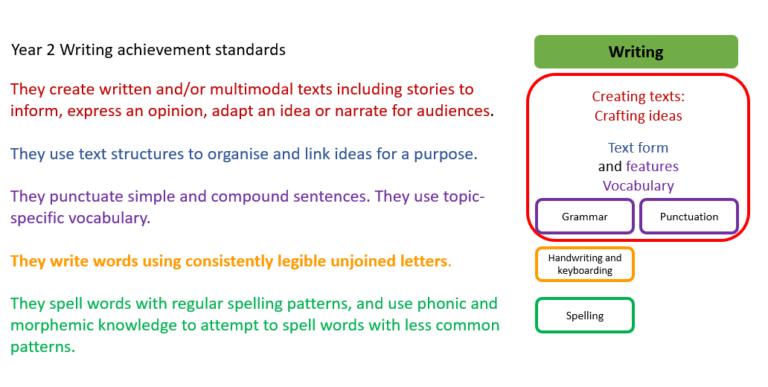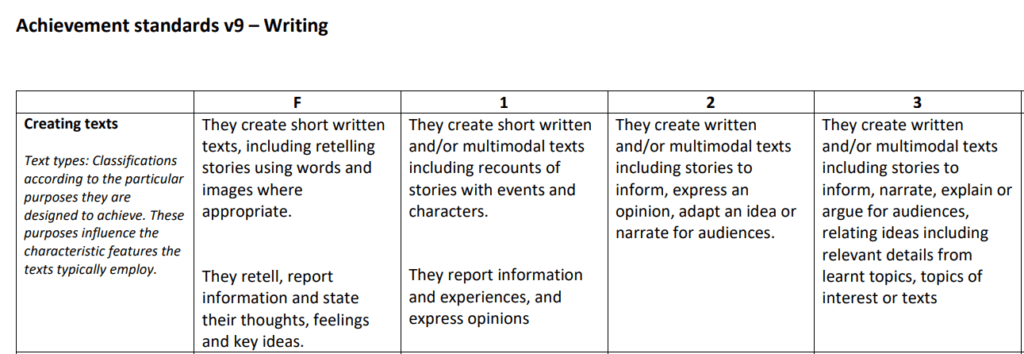The new, improved English Achievement Standards.

By KELLIE
The Australian Curriculum: English achievement standards were revised in May 2022. Three significant revisions in v9.0 have improved the English achievement standards for writing.
There has been a lot of talk about the revised version 9.0 of the Australian Curriculum: English and the changes that have occurred to the content descriptions and elaborations. This article will focus on three significant changes to the Australian Curriculum: English achievement standards.
We will start by exploring the overhaul of the literacy general capability and then look at two ways this improvement complements the English achievement standards.
1. Literacy General Capability
Let’s start by discussing the revised literacy general capability.
The v9.0 literacy general capability is very different from the previous version. Not only is it structured differently, but the progressions within the capability are no longer banded. The literacy general capability now reflects a more nuanced, research-based understanding of how literacy develops. (Remember how difficult it was to try and describe the learning taking place between the end of year 2 and the end of year 4?)
Now, the Literacy general capability is essentially the National Literacy Learning Progression. You may be familiar with the Literacy Learning Progression released by ACARA a few years ago. These progressions are very helpful as they describe the observable indicators of literacy development. These indicators reflect the typical trajectory of the development of literacy skills.
ACARA itself gives us a clue as to how important this revision is; “The Literacy progression complements the Australian Curriculum: English by providing more fine-grained descriptions of literacy development, to support teachers to accurately monitor students’ literacy development, across all learning areas.”
This is great news for teachers. This alignment is going to be very helpful when it comes to recognising those nuances in literacy development that were hard to distinguish in the ‘old’ literacy general capability.
Let’s look briefly at the new look literacy general capability.
What does the literacy general capabilty now look like?
- Elements
The literacy general capability now consists of three elements.
- Speaking and listening
- Reading and viewing
- Writing
This structure acknowledges the importance of each of these aspects of literacy development, and how they are interconnected.
- Sub-elements
Each of the elements consists of sub-elements that represent “evidence-based aspects of literacy development” (ACARA, 2022). The sub-elements are the relevant knowledge and skills that underpin each of the elements.
The Writing element has five sub-elements:
- Creating texts (including crafting ideas, text form and function, and vocabulary)
- Grammar (accuracy, group and word level, sentence level, and whole text level)
- Punctuation
- Spelling
- Handwriting and keyboarding.
The Creating Texts sub-element is described as being holistic and is supported by the others. This means that teachers can refer to the other sub-elements for further clarification or refinement.
- Progression levels
The sub-elements are organised into progression levels. These describe how students typically become increasingly proficient in literacy. They are what ACARA is referring to as “the more fine-grained descriptions of literacy development”.
These progressions contain observable indicators that describe what students may say, do or produce at each level. They are coded with a P and a number to show the increasing levels. As you would expect, the indicators become increasingly more complex than the previous sets. This results in a continuum of teaching and learning.
The number of progression levels for each sub-element has been determined by research evidence. The diagram below shows how the writing element is organised with the range of progression levels within each sub-element.
These levels are aligned to the AC: English year levels. Foundation starts at P1 and then progresses through various levels until completion depending on when students are typically proficient. There is often more than one progression level within a curriculum year. You can see in the diagram that Handwriting and Keyboarding have eight levels and these are aligned with the Foundation to Year 4 English curriculum.
How has this improved the English Achievement Standards?
This is where it gets exciting. It is through these ‘parts’ of the literacy general capability that we can see one of the big changes in the new curriculum revision: the adjustments to the v9.0 English curriculum achievement standards. These improvements are going to be very helpful to teachers and influence the way we teach, monitor, and assess writing.
Let’s now explore how the curriculum now aligns with and is complemented, by the literacy general capability through the English achievement standards for writing.
2. The achievement standards reflect the elements.
The English v9.0 achievement standards have been revised to align with the elements of the literacy general capability.
As discussed previously, there are three elements of the new Literacy general capability:
- – Speaking and listening
- – Reading and viewing
- – Writing
There are now also three paragraphs in the new achievement standards in English! This is not a coincidence. The three paragraphs align with the three elements. (I know right? This makes so much sense!)
The first paragraph of the English achievement standards is about students’ capabilities in speaking and listening, the second in reading and viewing, and the third in writing.
This image shows how the English achievement standards in v9.0 are written in three paragraphs reflecting the elements of the literacy general capability.
3. The achievement standards reflect the sub-elements.
It is not only the structure of the achievement standards that has changed to align with the literacy g.c., the year-level expectations for students are further mapped to the sub-elements.
When we unpack the writing paragraph for each of the year levels from Foundation to Year 6 we find there is a pattern. The statements of year-level expectations are arranged in a similar way for each year level.
- The first few statements in the writing achievement standard paragraph are aligned with the Creating Texts sub-element. Generally, the first statement of the achievement standard aligns with crafting ideas, the second statement with text form, and the next statement(s) with text features (incorporating vocabulary, grammar, and punctuation).
- A statement aligning with the handwriting and keyboarding sub-element follws. Although there is no mention of keyboarding in the revised English achievement standards and in line with the progressions themselves, this does not continue beyond year 4.
- Finally the paragraph is completed with a statement about students’ spelling capabilites.
That is probably as clear as mud! The following diagram will help explain it further. Here the Year 2 writing achievement standards are colour coded to show how they align with the sub-elements embedded in the literacy general capability.
What does this mean for the teaching of writing?
This is exciting as this alignment of the achievement standards with the literacy progressions has such great potential to support teachers of writing.
In future articles, we will discuss possible ways that these changes to the English achievement standards can be applied to the teaching, monitoring, and assessment of writing.
While you wait, download the F-6 curriculum document below and explore the new structure to the English achievement standards in writing. (You never know we might feel inclined to work on the Speaking and Listening and Reading and Viewing achievement standards one day too!).
Please let us know if this breakdown of the English achievement standards has been helpful!
F-6 Australian Curriculum: English achievement standards
This free document shows the breakdown of each of the year-level English achievement standards for writing aligned to the literacy general capability.
Viewing the achievement standards in this way helps to show the progression of literacy development in each of the sub-elements across the curriculum year levels.
You can download this here.
Australian Curriculum:English v9.0 achievement standards showing alignment to the literacy general capability. (Writing).
Foundation to Year 6.
Would you like to talk more about the changes to the English Curriculum and the implications for teaching writing? We’d love to hear if you found this article useful! Join us in The Lounge.
“The Lounge” is Quality Writing Instruction’s Facebook group, where you can share ideas and get support from a fabulous group of like-minded teachers.
References:
Australian Curriculum, Assessment and Reporting Authority [ACARA], 2022. Literacy. https://v9.australiancurriculum.edu.au/teacher-resources/understand-this-general-capability/literacy
If you’d like to explore the literacy general capability even further you can do so here.




